Sounds like a truly unforgettable experience, right? Something about babies playing in the sand and wearing beach hats just screams memorable. Yes, there are a lot of fun activities for a baby at the beach, but one thing you have take into account above all is safety.
With the sun blazing and your little child eager to explore the sandy-watery world around them, you have take the necessary precautions to ensure that nothing endangers your baby.
Many parents feel discouraged to take their baby to the beach, but this article aims to educate you about all the safety tips you need in order to enjoy this unique experience.
In the following article, we will explore all the safety precautions, essentials that you have to bring, various fun activities for your baby to enjoy, and a few baby beach hacks, too.
Packing for a Baby’s First Beach Trip
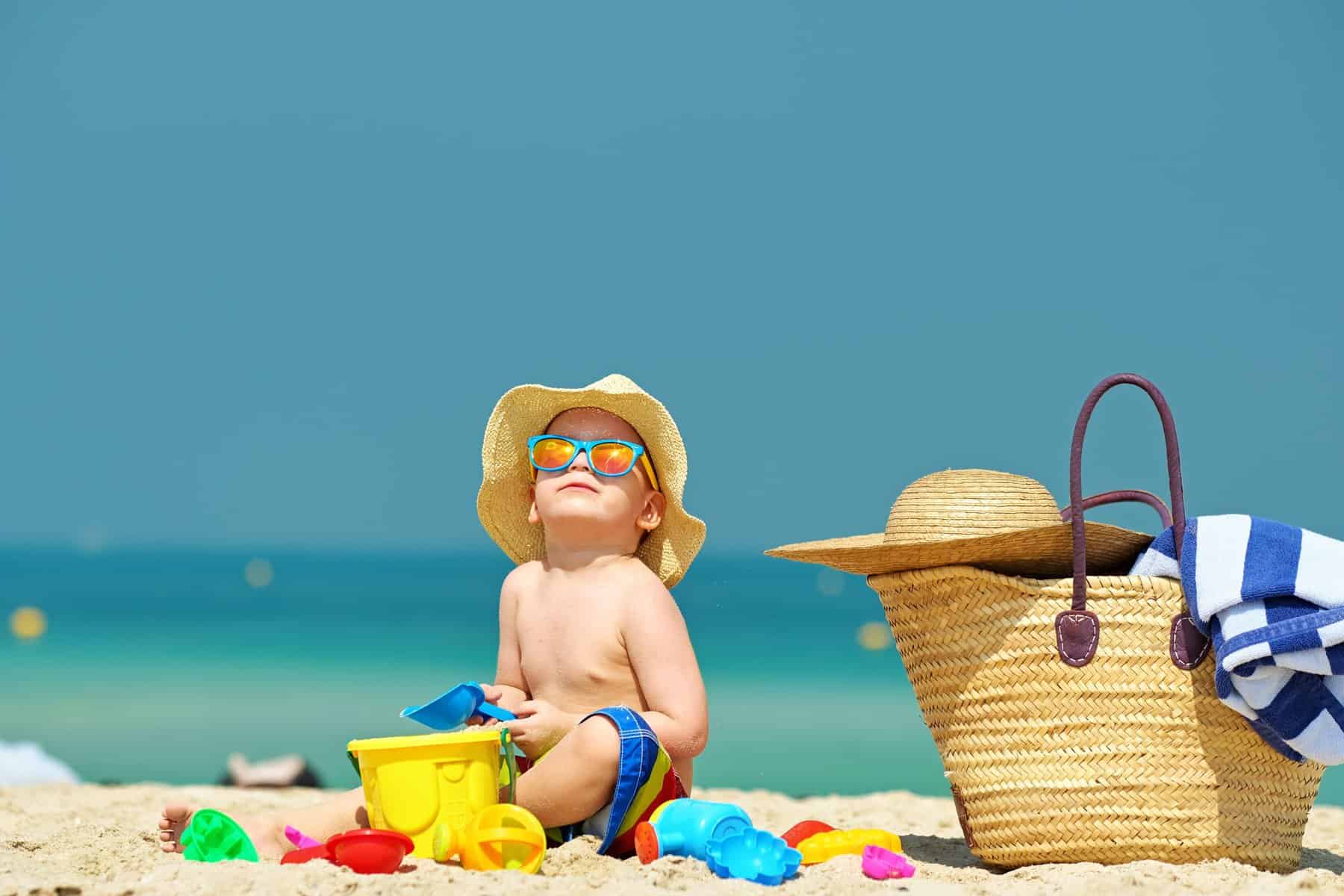
Before we start talking safety – here’s what you need to bring to the beach.
First of all, you need to take into account your baby’s age. The general rule of thumb strongly advises that you shouldn’t take your baby to the beach until they’re older than two months. More so, remember never to apply sunscreen to babies under six months.
However, if your baby is over six months of age, it’s still equally important to use proper clothing protection and to keep your baby in the shade so as to minimize sun exposure.
To provide adequate shade, make sure to pack a baby beach tent.
Before you purchase a beach tent, however, make sure that you do your homework and ensure that the tent has adequate protection from the sun. This area will be your baby’s safety capsule and where they will spend most of their time, either playing or napping.
A beach tent also provides enough space for you to keep your essentials neatly stored.
Aside from the beach tent, you will need sunscreen if your baby’s over six months. Pack extra because you will be doing a lot of reapplying. How often? It’s generally advised to reapply sunscreen to babies every two hours in order to provide adequate protection.
Remember to use sunscreen even if it’s cloudy at the beach. Regardless of the weather, if you’re taking your baby to the beach, don’t forget to apply sunscreen regularly. Also, if your baby gets wet, that means that you’re going to have to reapply sunscreen again.
What about clothes? Yes, your baby’s going to need extra protection in the form of UV baby swimwear. These types of clothes are specifically designed to protect your baby from the sun. Also, you’re going to need swim diapers if your baby’s not potty trained.
What else? Well, it’s advised to have a first aid kit at hand in case of an accident.
Pack enough food and drinks to last the whole day, and if you’re having doubts about quantity, it’s always better to slightly overpack. Make sure not only to keep your baby cool, but fed and hydrated, as well. Aside from that, don’t forget to bring baby toys.
Optionally, you can bring a fan to help your baby stay cool, a stroller to keep all your essentials neatly stored in one place, a spare sun hat in case your baby loses the one they wear, plenty of blankets and beach towels, frozen food for a teething baby and a cooler.
Yes, there’s a lot of things to consider, so let’s make a checklist:
1.Sunscreen for a baby older than six months.
2. A baby beach tent to provide shade.
3. Bring UV baby swimwear and a baby sun hat.
4. Swim diapers to prevent accidents.
5. Make sure to bring a first aid kit.
6. Pack enough food and drinks.
7. Let’s not forget baby toys.
8. Towels, accessories, and extras.
When you’re taking your baby to the beach, it’s all about preparation. Pack everything you need so that you can enjoy a fun and stress-free time with your baby at the beach.
Baby’s First Trip to the Beach: Safety Tips

Let’s talk safety.
Naturally, a baby at the beach needs to be protected against the sun. That’s your number one concern. If you have prepared adequately, then you have little to worry about. With protective clothing, sunscreen and enough shade, your baby’s going to be just fine.
A baby at the beach should never be left unattended, especially if you go into the water. When you do go inside, keep it short. Take frequent breaks. Remember also to rehydrate your baby when you’re out and to help cool them off in order to prevent heat exhaustion.
You may also consider using an inflatable floating device to keep your baby afloat in the water. Either way, be present with your baby. Keep an eye on them. Don’t get distracted.
Another health risk you have to keep in mind is dehydration.
Unlike adults, babies are very prone to dehydration. A baby at the beach can easily experience it due to intense heats. As such, it’s your responsibility to keep your baby well hydrated. Remember to cool them off regularly and watch out for dehydration symptoms.
So as to minimize any health risks due to sun exposure, plan taking your baby to the beach early in the morning or late in the afternoon. You want to avoid staying at the beach when the sun is at its highest. Also, make sure to plan for days that aren’t extremely hot.
Something else you have to consider is accidental injuries. A baby at the beach is exposed not only to the sun and the water, but different types of accidents, too, such as hot sand, trash, sharp rocks and even crowds. As such, try to avoid going to overcrowded beaches.
When removing sand, remember that your baby’s skin is sensitive. Do so gently and patiently. If you’re looking for baby beach hacks, try using cornstarch to remove sand. It’s surprisingly effective since it dries the skin, allowing you to painlessly wipe off the sand.
Above all else, keep your eyes on your baby. The most important part when it comes to taking your baby to the beach is preparation. However, when you’re there, it’s all about keeping an eye on your baby and making sure that they’re cool, hydrated and safe.
Let’s recap potential safety hazards that you have to watch out for:
- Sun exposure, hot sand and other surfaces.
- Increased risk of dehydration.
- Risk of sharp trash and rocks.
- Waves and rip currents.
To help prevent accidents and to minimize risk, follow our necessary safety tips. A baby at the beach needs constant monitoring whether in or around water. Dress your baby for the heat, mind the temperatures, and make sure to prepare for the beach accordingly.
Creating Memories and Having Fun
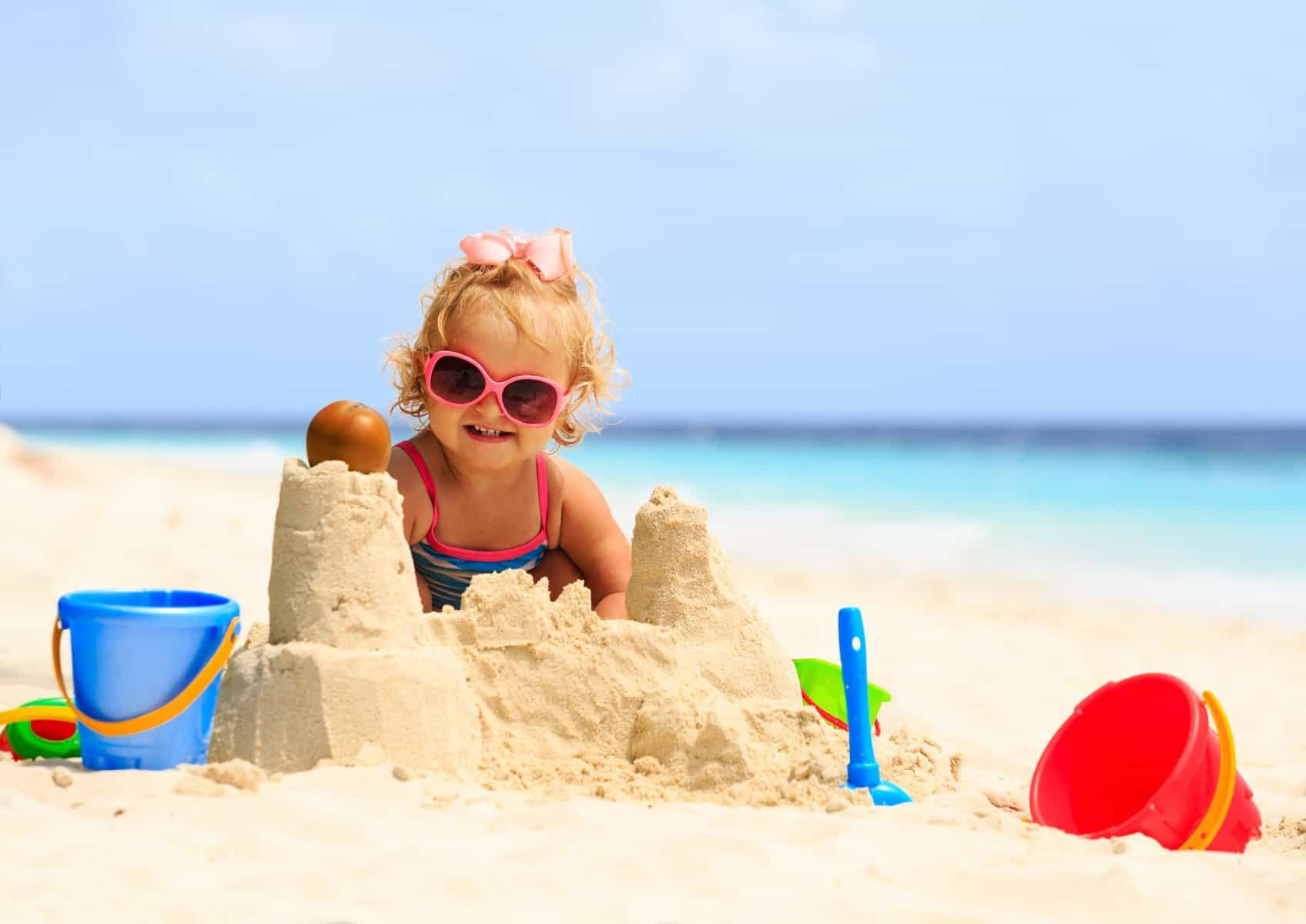
Taking your baby to the beach for the first time makes for a truly memorable experience, one that will certainly bring you immense joy as a parent. On top of that, it’s a unique experience for the whole family to enjoy and make some new beautiful memories.
There is a great variety of fun and engaging activities for a baby at the beach.
Everything is new and exciting for your little one. As such, exploring this sandy world through your baby’s eyes will bring a smile to your face. If you have taken care of all the safety precautions and packed everything – let’s start exploring fun beach activities.
1. Let’s start simple. How about a nice and pleasant beach walk?
Walking along the beach is a great way to familiarize your baby with this new and exciting environment. However, if your baby’s too young to walk, you will need a baby carrier.
Ideally, the beach shouldn’t be overcrowded.
Pick a nice and calm part of the beach. During the walk, talk to your baby. Teach your baby about the surroundings by pointing to interesting things and letting them gaze in wonder. Don’t forget sounds. Listen to the gentle crashing of the waves and the seagulls.
Aim to activate your baby’s senses, but mind the heat.
Spending too much time out of the shade can endanger your baby.
2. Introduce your baby to the sand by playing a sand sensory game!
Of course, you don’t want your child to scoop hot sand. You can provide dry sand so long as you make sure that it’s not hot, but it’s best if you provide a bucket of wet sand, too.
Let your child interact with the sand in order to develop their sense of touch. You can introduce additional objects so long as they’re safe for your baby to interact with.
This sensory game allows your baby to explore different shapes and textures. Keep in mind that a baby at a beach is going to feel like a proper explorer, so it’s important that you provide all the resources they need to learn and develop in a safe environment.
3. When you take your baby to the beach – bring toys!
Bring your baby’s favorite toys, but don’t forgot to pack beach toys, too. Depending on the baby’s age, a shovel makes for an excellent beach toy, allowing your little one to discover the joys of digging and moving around sand. Scoops and cups are always welcome, too.
With these objects, you can introduce your baby to the world of sand castles. Show them how to build structures in the sand by using cups and then let them try on their own.
Remember to mark this special occasion by taking photographs after you and your baby have built your first sand castle. It’s going to be a beautiful piece for the photo album.
4. Take peek-a-boo to the next level by hiding objects in the sand!
Again, this game of buried treasure can’t be played in hot sand. You don’t want your baby getting burned. For example, you can hide a toy in the sand and navigate your baby as they try to find it. Consider giving your baby a shovel as they dig to find the treasure.
You can repeat this game as many times as you want and even hide multiple items, too.
This game is a great example of sensory play that develops your baby’s memory, boosts their hand-eye coordination while also stimulating your baby’s desire for exploration.
5. Before heading out into the water, let your baby chase waves!
At first, you can carry your baby in your arms and show them how it’s done. Keep your feet dry as waves come and go. Depending on the age of the baby, you can let them try on their own under your surveillance. Especially be mindful of any hidden trash or rocks.
After all, a baby at the beach needs to wear beach sandals or shoes all the time. You don’t want their tiny little sensitive feet getting in contact with the smoldering sand. By the end of this game, reward your baby by letting them wait for the water to touch their feet.
Eventually, you can venture out into the shallow water with your baby, but you need to exercise extra care and make sure that you never leave your baby unattended in water.
6. Head out into the water and the waves with a swim ring!
When the waves are calm and the weather’s pleasant, head into the water with your baby. A baby at the beach can only learn so much; it’s inside the water that they’re going to have the most fun. However, it’s important that you always prioritize your baby’s safety.
With a swim ring your baby gets to enjoy a floaty time in the water.
A swim ring allows your baby to feel a sense of independency, because you’re not directly holding them in your arms. Make sure that you’re there for your little one so that they don’t get scared. Always keep your eyes on your baby. Don’t leave them unattended.
Even though you have a swim ring, it’s important that you stick to the shallows so as to minimize any risks. After all, it’s all the same for your baby. Do a little splashing to make your baby laugh and smile, and make sure to allow them to splash you back, as well.
7. Help your baby make a pool!
Most of these activities depend on the baby’s age. With a toddler you get to share the experience directly. Nevertheless, you can do these things with a younger baby, too, by letting them observe. They’re certain to be fascinated by all the activities you get up to.
Creating a pool with ocean water is a fun and engaging activity for your baby. There are two ways you can go about it. Equip your baby with a shovel and let them dig out a hole. Then, use a bucket to transfer water from the ocean into your newly constructed pool.
On the other hand, you can also dig out a hole by the water by making trenches and propping up sand walls. The waves then act in your favor, filling your pool with water.
This activity stimulates your baby’s brain in many ways, and is loads of fun, too!
8. Bring a bag and get collecting!
Take your baby with you as you explore the beach. Find something you like? Show it to your baby. If it makes them smile, slide it into the bag! Anything your baby points to, from rocks to sea shells goes in the bag. Go an extra step and bring one bag to pick up trash.
Make sure to wear protective gloves if you’re going to do a little beach cleanup.
Explain to your baby the importance of preserving the environment and the importance of keeping things clean and orderly. By doing this you teach your baby a valuable lesson.
All the goodies you collect off the beach will make for a wonderful collection that’s going to have immense sentimental value as time goes by. You may also want to consider getting artistic and using your creativity to paint the rocks and seashells you find on the beach.
Then, you can even teach your baby selflessness and kindness by having them gift the rocks you paint (although not all of them) to the strangers on the beach! Some you want to keep for yourself in order to have a nice memory of your first trip to the beach together.
9. Nothing says fun quite like a beach ball!
Ideally, you want a large inflatable beach ball that doesn’t require much strength for you or your baby to kick it around. The best part about playing with inflatable beach balls is that it develops your baby’s gross motor skills and sharpens their hand-eye coordination.
There are numerous games that you can play with a beach ball, but the old classic game of just tossing it and kicking it around is certain to be a blast for the whole family. To make things interesting you can even play in teams and create your little own volleyball court.
So, when you take your baby to the beach, make sure to bring a beach ball!
10. Read to your baby and write in the sand!
When you’re resting in the shade, you can work on teaching your child letters and words by using a stick and writing into the sand. Also, you can always unwind with a little bit of reading when you’re taking a break from different activities and hiding from the sun.
Make sure to bring books that are appropriate for your baby’s age. For example, if you’re reading from an illustrated book about animals, show your baby the animal than try to draw it into the sand. This makes for a fun activity that stimulates your baby’s creativity.
By including reading into your beach routine, you help your baby develop their language skills and their listening skills. Reading might be considered boring for a baby at the beach, but keep in mind the number of breaks that you will take to hydrate and cool off.
Essential Baby Beach Hacks

Now that you’re familiar with all the safety tips, know what to pack, what kind of activities to plan – let’s take a moment to get you up to speed on some baby beach hacks.
A baby at the beach doesn’t need to actually go into the water if you’re unwilling to take them yet due to their young age. However, there is an alternative that you can consider. An inflatable pool allows your baby to splash and have fun without going into the ocean.
The best part about inflatable pools is that you can keep your baby in the shade.
That way, you’re minimizing the risk of sun exposure on your baby’s sensitive skin.
Also, make sure to pack baby hand sanitizer. Bring some for yourself, too.
There’s a lot of germs out there and you want to make sure that your baby’s hands as well as your own stay clean by applying an antibacterial hand sanitizer every now and then.
When it comes to baby beach hacks, nothing beats a water bottle spray.
Bring a water bottle spray with cool, icy water to splash your baby whenever you see their cheeks getting flushed – especially if it’s really hot outside. Of course, you want to avoid the midday sun at all costs, but a water bottle spray can help cool your baby off anyway.
It’s all right not to bring toys, since the beach and the ocean are playgrounds in and of themselves. If you’re feeling overburdened with bringing so much stuff and lugging it all around, you can drop some items off your checklist and not miss out on the fun.
So, when you’re taking your baby to the beach, know that the playground is already set.
Another tip we have for you is to bring an extra beach hat for your baby.
It can get especially windy on shores. So, the wind might blow the hat off your baby – and maybe you’ll be too busy to go chasing it. It can happen in water, too. You shouldn’t ever leave your baby unattended when you take them to the beach, so bring a spare beach hat.
In fact, make sure that you have most of your essentials in spare.
Choosing How Long to Stay
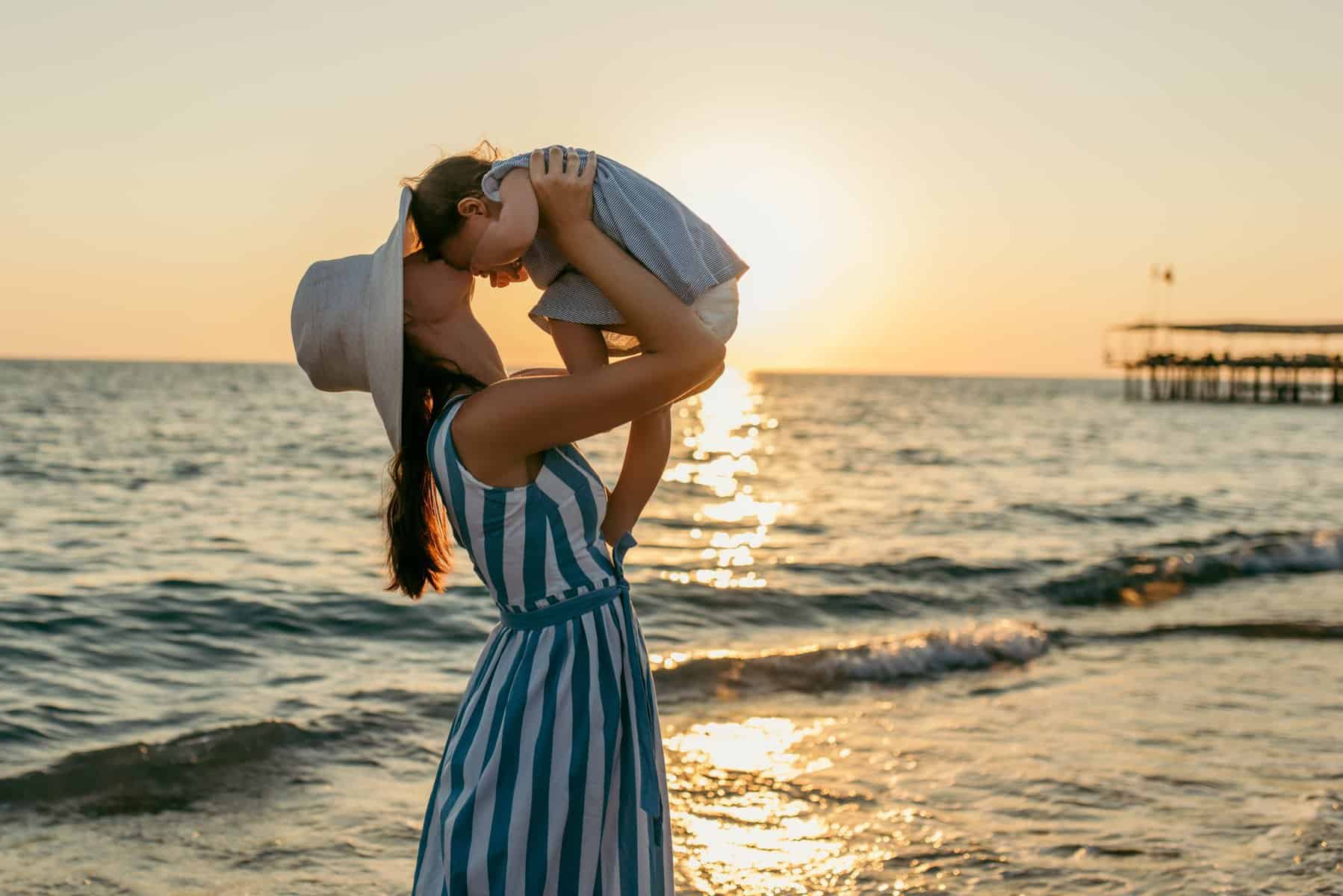
A baby at the beach can’t stay for long periods of time – that goes without saying. They have sensitive skin and despite all the precautions and the protection, it’s advised to limit your time spent under the sun, regardless of whether or not you’re sticking to the shade.
The first factor you have to take into consideration is, of course, your baby’s age.
Plan your trip accordingly. Going to the beach is always fun, but let’s be smart about it.
For babies under six months, the general rule of thumb indicates one to two hours. That’s because babies at this very young age can’t regulate their bodily temperature and are extremely sensitive to heat. If your baby’s over six months, you can prolong your stay.
Also, when you’re planning on taking your baby to the beach, you have to consider the weather. Ideally, you should aim for months that aren’t too hot. In fact, it’s perfectly fine to take a trip to the beach on cloudy weather, too, in order to minimize your baby’s risks.
Another factor you have to take into account is your baby’s needs. Does your baby get tired easily? Your child can nap in a baby beach tent, but you don’t want to exhaust them.
That said, perhaps the best option is to plan for multiple short trips to the beach, rather than staying for the whole day. Most experts advise that it’s not safe for a baby to spend the whole day at the beach. Instead, plan for multiple visits throughout the week.
That way you’re limiting any potential risks in regards to sun exposure.
After the first trip, reflect on how your baby reacted. Did they love it? They surely must have. A trip to the beach is always fun, exciting and engaging for the whole family. So, take your lessons and be flexible in the future so as to be able to meet your baby’s needs.
In Conclusion
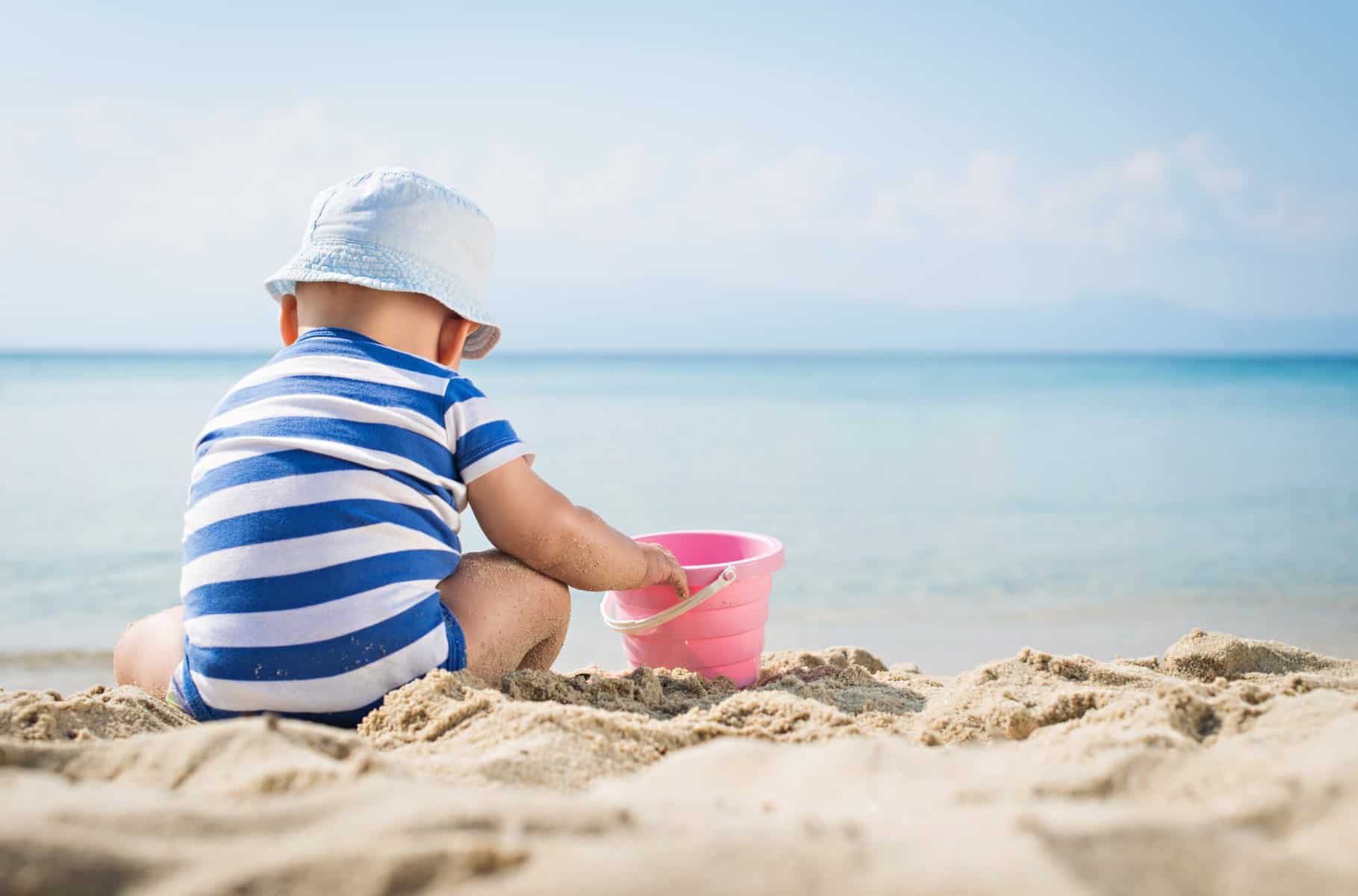
With so much to consider, it can even seem daunting. Rest assured, however, that there’s nothing scary about taking your baby to the beach so long as you follow our safety tips.
Do your planning well and you will enjoy a stress-free experience. Not to mention all the fun and exciting memories that you will make when you see your little one playing in sand or splashing about in the water. Just remember to keep your beach trips short.
After you finish up the planning, write a list of all the activities that you want to do with your baby – and don’t forget to snap photos! You will want to frame the picture of that sand castle that you built together or to store all the sea shells collected in a jar!
Remember to relax and enjoy yourself. Keep an eye on your baby. Mind the dangers, the risks, but know that you don’t need to stress if you’ve planned and prepared accordingly.

Mother of three and a primary school teacher. I’ve always loved being around children and helping them, so I chose my path as a teacher. It is sometimes hectic with three children, but I am 100 percent into it and wouldn’t change it for anything in the world.

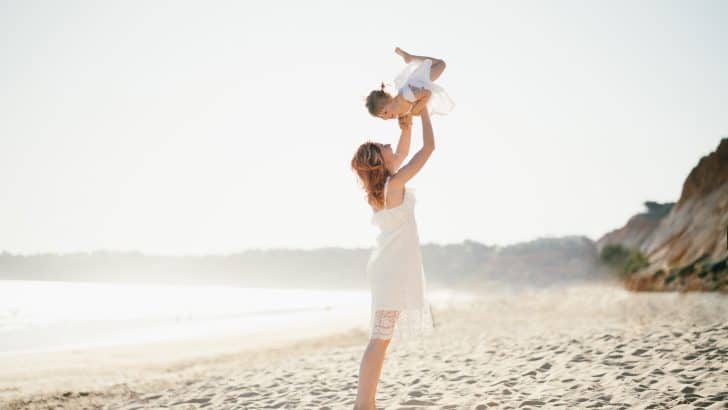
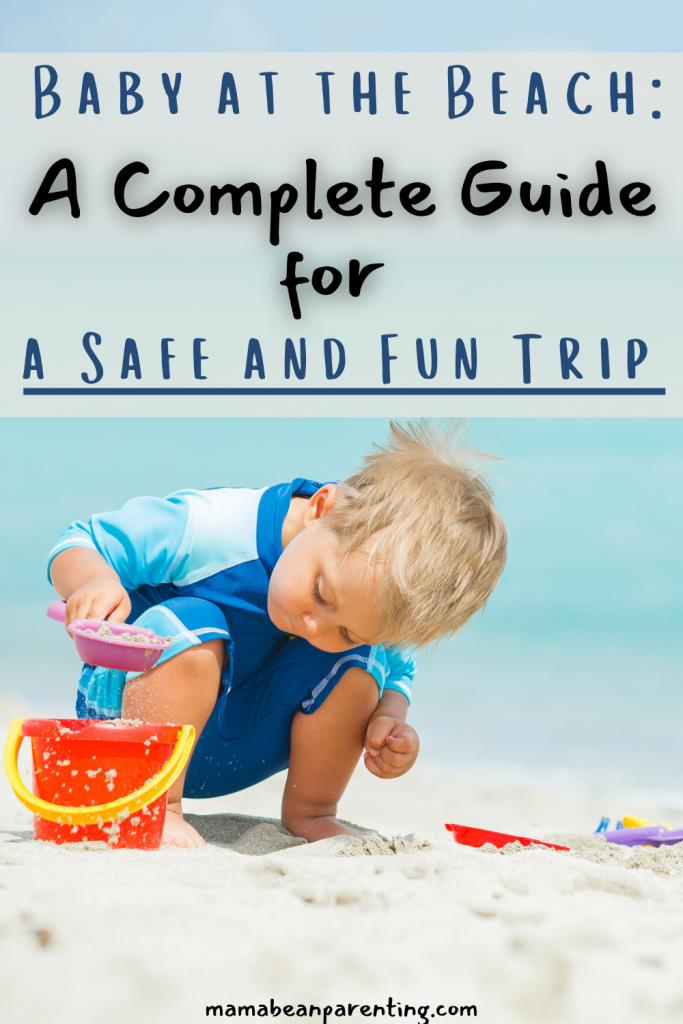
Practical Gifts For A 2-Year-Old • Mama Bean Parenting
Friday 27th of January 2023
[…] If you want to take the child to the beach, it’s good to have a complete guide for a safe and fun beach trip. […]